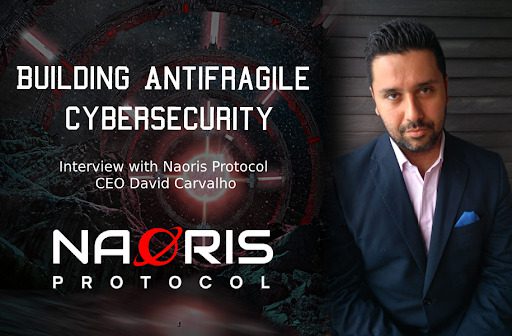Cybersecurity startup Naoris Protocol wants to raise the bar in the industry by combining the best elements of Web2 cybersec practices and blockchain technology. CEO David Carvalho sheds some light on how insecure devices can be turned into points of defense with ease, paving the way for a more interconnected world.
Cybersecurity Is A Blockchain Use Case
The world needs a new degree of cybersecurity solutions that do not compromise security or convenience of implementation, Naoris Protocol, founded as a standalone cybersec protocol, can turn every device into a cyber-trusted validator node. As networks grow, they often become less secure, but with Naoris’s approach, the opposite becomes true. The protocol eliminates all single points of failure and, with the help of blockchain technology, removes devices from their siloed environment and makes them part of a robust and secure network.
As Naoris Protocol CEO David Carvalho explains: “Our team was fully aware of the formations and existence of crimes, vulnerabilities, compromises, etc. that exist in the traditional or modern world thanks to existing experience and knowledge. We were also aware that managing the existing way i.e. with a diverse tool stack makes the problem more challenging.”
The blockchain industry remains popular due to the virtually limitless possibilities. It boggles the mind why so many developers and teams would opt for a similar approach to address scalability by compromising the security concepts, knowing too well such trade-offs should not even be considered.
Naoris Protocol is the missing key in this equation, yet does not become a single point of failure, unlike traditional cybersecurity solutions. It is complementary with other cybersecurity-oriented tools and helps convert existing network infrastructure into nodes securing the baseline to provide secure, trusted, and safe environments. That vision applies to Web2 and Web3 ventures alike.
Building the Decentralized Cybersecurity Mesh is crucial, as current cybersecurity measures are insufficient. Substantial attacks are still the norm rather than an exception, and overall costs are mounting. Despite growing spending on cybersecurity solutions – and more startups coming to market – attackers continue to gain the upper hand. The time has come to pursue a radical approach to cybersecurity, and involving blockchain technology makes a lot of sense.
Moreover, the world continues to see an influx of internet-connected devices. This year, that number will surpass 50 billion connected devices, which traditionally incurs more points of failure. With Naoris, the growing number of connected devices leads to more resilient solutions, regardless of network or ecosystem complexity. Moreover, it will brink down overall costs associated with cybersecurity measures by turning existing devices into cyber-trusted points of defense.
Transitioning From Web2 to Web3
Overall demand for blockchain solutions continues to grow exponentially due to the impending shift to “Web3”, or the decentralized internet. The current vision of Web3 revolves around user empowerment through blockchain technology and cryptocurrencies. That, too, will require cybersecurity-oriented solutions and a different approach to achieving that goal. David Carvalho continues:
“The Naoris team was able to improve upon the previous findings [of blockchain research], and with the assistance of asynchronous liveness, zero-overhead, post-quantum safety, and practical low latency fast path, they were able to achieve one million on transactions per second with a latency of only five seconds while utilising 2000 nodes.”
Those numbers may seem overkill, although a decentralized internet would require that caliber of throughput or more. Recording every action undertaken on the internet by every individual user around the world generates tremendous amounts of data. All of that information needs to be streamlined and processed accordingly without delays and at a minimal cost.
Naoris Protocol will offer a hybrid approach to facilitate the transition from Web2 to Web3. CEO David Carvalho told us that “Naoris embraced the idea of combining the best of Web 3.0 and Web 2.0 since we were active participants on both sides. Many issues, including mutability, influence issues, consensus availability, authoritarian character while making decisions, etc., were immediately remedied when connecting to Web 3.0.” That foundation paved the way for building an ecosystem addressing blockchain-specific concerns and issues, including smart contract coding, plagiarism, spamming, malicious changes, etc.
Using Web3 technology and infrastructure to scale Web2’s fundamental problems enables Web3 to scale further than previously considered possible. Moreover, it highlights one of the handful of real-world blockchain use cases, as cybersecurity remains the biggest tech trend predicted by Gartner for the next decade. Decentralizing cybersecurity is the next logical frontier to explore, and the air-gapped Distributed Proof of Security consensus mechanism illustrates the need for multiple layers of decentralization in this segment.
Anti-fragile Blockchain Technology
A blockchain serves as a distributed ledger where information is, by default, immutable. Naoris Protocol, on the other hand, uses an anti-fragile process to facilitate future expansion and broader utility. Such concepts may seem foreign and counterintuitive when thinking of immutable ledgers. However, David Carvalho explains how all of this will work:
“Swarm AI is one of the key elements supporting the Naoris Protocol. The most advanced forms throughout the ecosystem are designed to gather insights anonymously and learn over time. The addon is intended to support judgments that it learns through repeated compromises, crashes, and recoveries. This will ease initially with a simpler procedure like applying routine updates, but as it matures, it will apply routine fixes and attempts that go along with them. Overall help to self-heal in every situation where there is a common definition to the reappearing problem.”
Anti-fragility becomes a powerful concept when one considers the many cybersecurity concerns that exist today. Web3 will undoubtedly inherit the flaws and concerns found in Web2 today and add a new layer of potential flaws to consider. Naoris Protocol is designed in such a way it can complement the existing solutions and provide a better protection layer for current and future projects. Carvalho continues:
“We don’t want everyone to be a cybersecurity expert, have knowledge or for there to be any learning to participate also, we reward people for contributing resources to the network, and distribute even more rewards based on each device’s strength to the network. The Naoris Protocol is not intended to replace the preexisting ecosystem for cybersecurity; rather, it is intended to supplement it. It is helpful in bringing trust among devices that previously lacked confidence in intranet or the internet.”
The future of the internet may look very different from what we use today. Whether it will be a decentralized form or a hybrid approach of centralized and decentralized concepts remains to be seen. However, the development of solutions like Naoris Protocol shows there is a growing need for better infrastructure, both scaling-wise and security-wise. There is much room for progress on the cybersecurity front, an aspect many teams tend to overlook. Convenience and accessibility should never trump security, unlike what we have seen with Web2 to date.



































